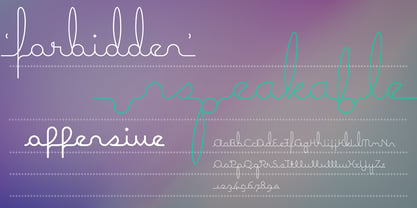Seleccione este tipo de licencia cuando esté desarrollando una aplicación app para iOS, Android o Windows Phone, y vaya a incrustar el archivo en el código de su aplicación móvil. va a incrustar el archivo fuente en el código de su aplicación móvil.
Expletive Script
por Barnbrook Fonts




- Aa Glifos
-
¡Mejor PrecioPaquetes de familia
- Estilos individuales
- Especificaciones técnicas
- Licencias
Por estilo:
$30.00
Paquete de 4 estilos:
$120.00
Sobre la familia Expletive Script Fuente
Expletive Script es un fuente modular basado en una forma circular. Sus caracteres pueden situarse por encima o por debajo de la línea de base para crear una tipografía inusual y complejos patrones repetitivos. Expletive Script tiene un espíritu lúdico y una geometría sencilla que la hacen adecuada para una gran variedad de usos, desde detalles finos hasta titulares expresivos.
Diseñadores: Marcus Leis Allion, Jonathan Barnbrook
Editorial: Barnbrook Fonts
Fundición: Barnbrook Fonts
Fundición original: unknown
Propietario del diseño: Barnbrook Fonts
MyFonts debut: 18 de agosto de 2003
Acerca de Barnbrook Fonts
La fundición fuente de los diseñadores Barnbrook y Jonathan Barnbrook, antes conocida como Virusfonts. Creadores de Emigre Fuentes Exocet, Mason y Priori. Diseñadores de las portadas de los discos de David Bowie. Colaboradores iconoclastas de Damien Hirst y Adbusters. Creadores de marcas para grandes museos, emplazamientos y bienales de arte. El estudio tiene su sede en Londres y sigue trabajando en una gran variedad de proyectos culturales y musicales y exposiciones en museos.
Seguir leyendo
Leer menos